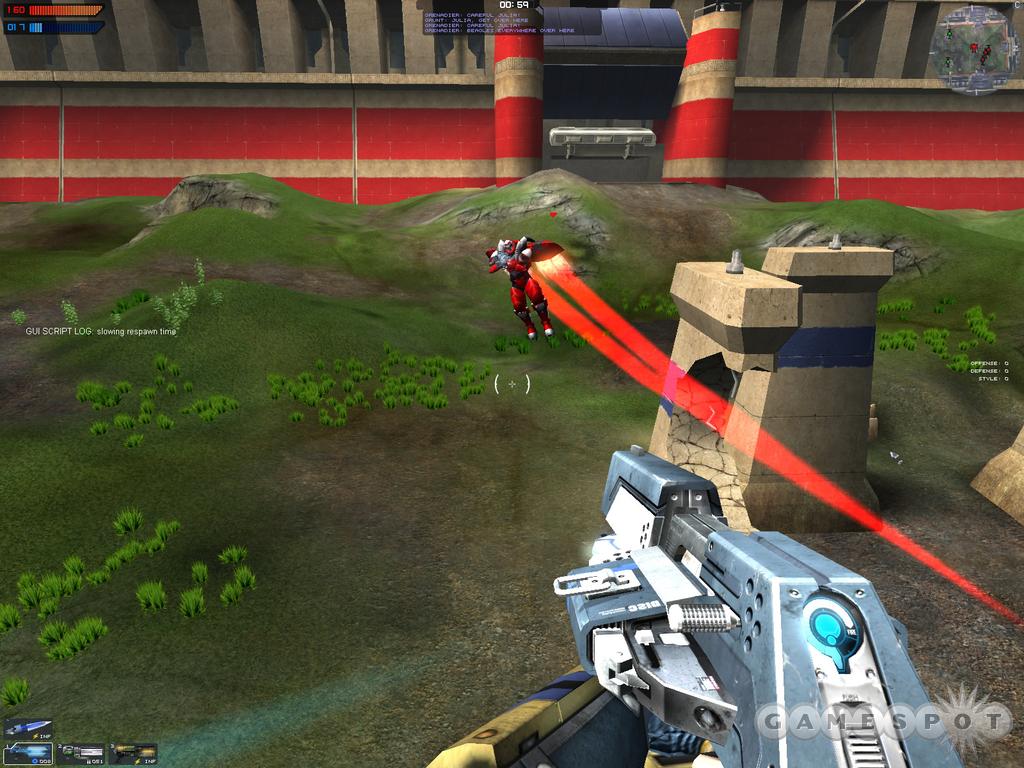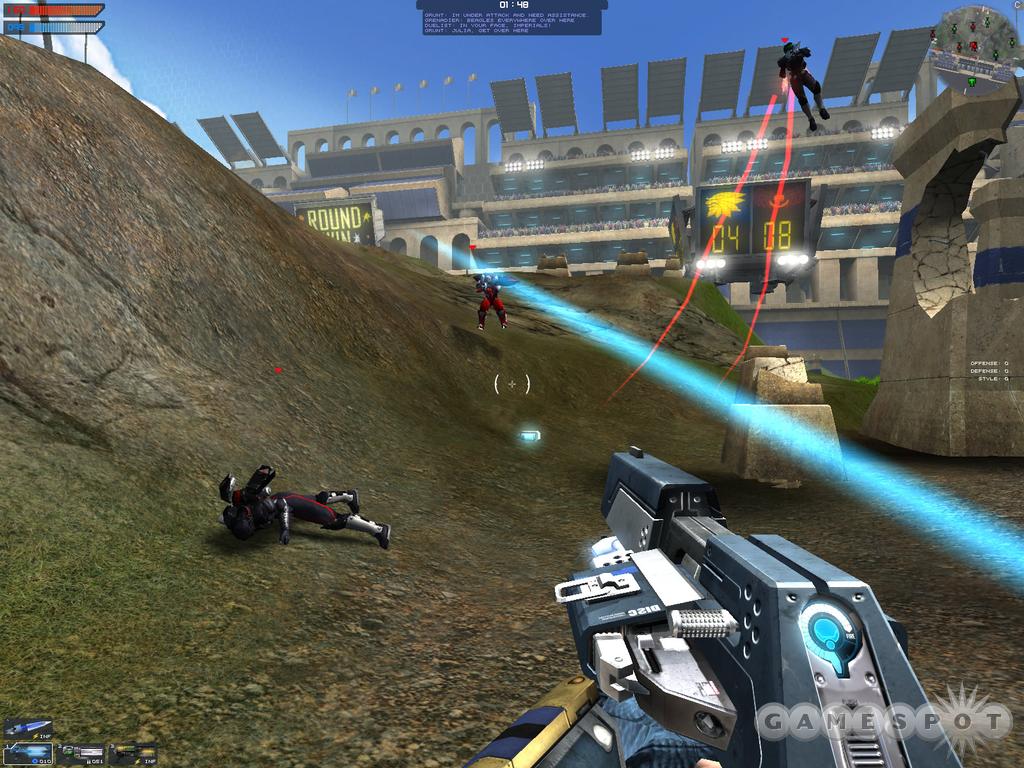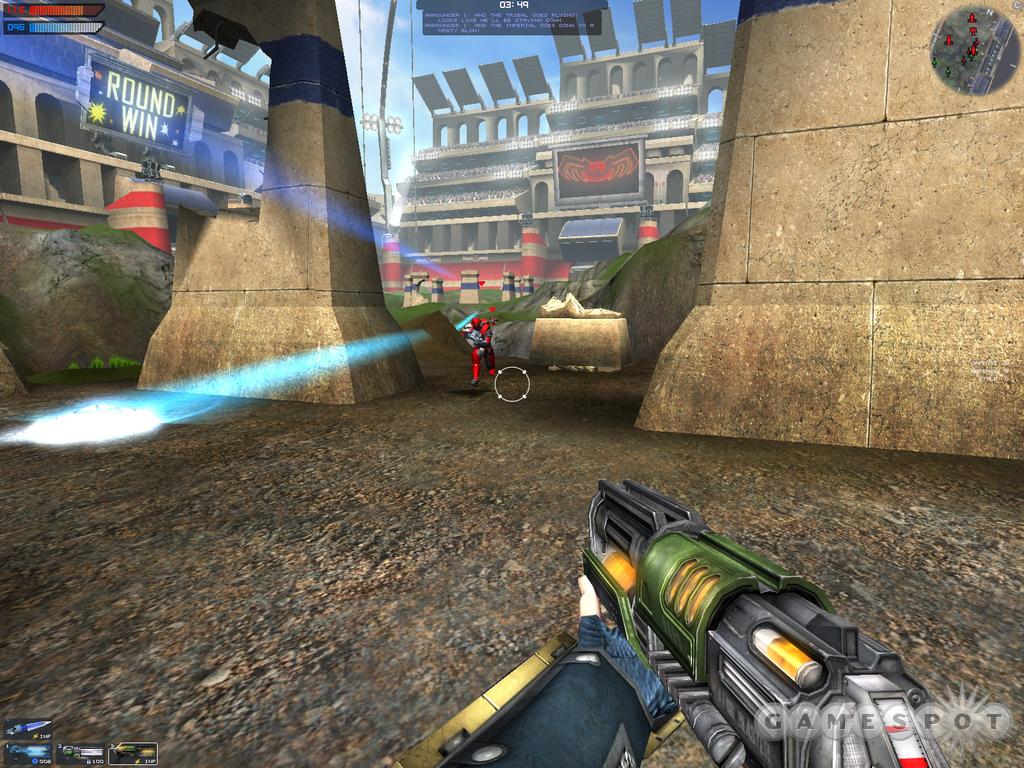Tribes: Vengeance Updated Q&A - Balancing Tribes
With Tribes: Vengeance nearing the final phase of development, we catch up with several members of the design team to get the latest details.
Some of the hottest first-person shooters on the market right now are the large-scale, team-based, multiplayer games that allow dozens of players to run around a huge level and blast each other with weapons and vehicles. Perfect examples of this are the Battlefield games and Joint Operations. You could say that the progenitor of this kind of game was Starsiege Tribes; that game introduced many of the concepts featured in today's games. Now Irrational Games is developing Tribes: Vengeance, the eagerly awaited third game in the Tribes franchise. Tribes: Vengeance is nearing the final stages of its development cycle, and we caught up with lead designer Ed Orman, senior designer Michael Johnston, lead programmer Rowan Wyborn, and producer Tony Oakden to get the latest from the bug-squashing front.

GameSpot: We understand that Tribes: Vengeance is in a beta test state. Could you give us an update on how the game, as a whole, is shaping up? How is the single-player campaign coming along, and judging from the testing you've seen so far, how well is the single-player game acting as a multiplayer primer?
Ed Orman: We've begun our closed beta, which is a limited release of the game, to a select group of people, most of whom have played Tribes: Vengeance before. Our intention is to use the closed beta period to begin taking feedback on balance and tuning, but also to iron out any major bugs before we open up the beta to thousands of people. So far, this has been entirely centered on multiplayer. We'll begin our closed testing of single-player very soon.
As a whole, the game is shaping up very, very well. Alpha was a great focusing exercise for us, and it's always surprising how much can be accomplished in the last few weeks before the milestone, and we're essentially feature-complete. Now we're approaching beta, during which all we'll have left to do is the monumental task of polishing single-player and tuning/balancing multiplayer, but we're in a very good position to do so.
GS: And more importantly for diehard Tribes: Vengeance fans, how is the multiplayer shaping up? Are we seeing the framework for large-scale multiplayer matches with huge numbers of players, or more intimate matches with players forming small squads? Are we seeing more multiplayer matches full of back-and-forth competition, or more momentum-based games?
Michael Johnston: The multiplayer game is taking shape. Tribes: Vengeance supports from 2 to 32 players, and 32 players is still a lot! We have a variety of maps that can result in both back-and-forth competition as well as more momentum-based games; but, in general, our maps are built in such a way that you should never feel like you have to go out and search for action. Even with smaller numbers of players on a server, your time to action is designed to be fairly quick, more like Tribes 1 than Tribes 2 in this respect.
GS: We know that one of the original goals for Tribes: Vengeance was to make mobility (and skillful use of the game's mobility options, like jump jets and skiing) at least as important as having good aim, if not more so. How are you making sure this is the case? How has this worked out in the recent testing?
MJ: More so than any other first-person shooter, Tribes: Vengeance is about the freedom of movement. Those players who learn how to move effectively have an advantage over those who don't. So our goal was actually to make it easier for new players to learn the basics of movement by making it more intuitive to acquire speed with jets and more forgiving to ski across a variety of terrain types. The single-player campaign also takes steps to teach players basic movement skills.
Having said that, the goal is also to allow you to keep improving your movement skills in the same way that you can keep improving your combat skills. The better you are at moving around, the more you can dodge during combat or even avoid combat altogether if you so choose. Importantly, these are real skills, not fictitious role-playing stats. Being skilled at movement involves anticipating other players, predicting their movement relative to your own, having a sharp awareness of your surroundings, using terrain to your advantage, managing your energy supply, and mastering the art of traversing landscapes quickly. The best players learn both movement and combat skills.
A Gameplay Hook
GS: We also know that the Tribes: Vengeance games make up one of the first shooter series to really emphasize teamwork over lone-wolf tactics. How have you designed, produced, and implemented the new game's features to continue to encourage players to work as a group? Now that the game is playable and being tested, how has this worked out in practice?

MJ: I think that team play can naturally emerge from a game. I played Tribes 1 competitively, there were all these great team dynamics that emerged. In real-world sports, I believe this emergent team play has a lot to do with the fact that a team is comprised of individuals who have a wide range of strengths and weaknesses. In a game like Tribes: Vengeance, I believe that, in the absence of the huge number of possible physical strengths and weaknesses that exist in sports, a similar effect can be achieved via equipment choice.
Everyone in Tribes: Vengeance chooses their own equipment and their own role depending on how they feel like playing or what they feel needs doing. This can be compared to classes in a game like Battlefield 1942, except that in Tribes: Vengeance you create your own "class" by combining equipment in various ways. However, you can't carry every piece of equipment like you can in a game like Unreal Tournament 2004. In Tribes: Vengeance, you can only wear one type of armor, carry one type of pack, carry one type of deployable equipment, and carry three types of weapons. The result is a game that lies somewhere in between Battlefield and Unreal Tournament, where choice is tempered carefully by restrictions in order to create a framework within which unpredictable yet structured gameplay can emerge.
So, on an individual level, you can custom-tailor your experience, which makes you more distinct and unique on the field compared to other players, and, in some situations, more valuable. There are a huge number of possible combinations of equipment, making it difficult to predict what players will learn what to do with them! Then, on a team level where you have groups of individuals combining their unique abilities in various ways, the results are even more unpredictable. You simply can't know how players will learn to work together to maximize their effectiveness in different situations.
This is part of the appeal of Tribes: Vengeance. We're trying to ensure that every single piece of equipment in the game is fun and useful. On top of that, some equipment is specifically designed with team play in mind. For example, the repair pack now has an area of effect. And, of course, we try to make it as easy as possible to coordinate your efforts via features like quickchat and a new in-game radar and command screen.
GS: We know that the grappling hook was one of the new weapons that was shown at E3. How will players end up using the item--both for beginners and for veterans who will eventually figure out every last trick in the book? Other than the grappling hook, what other new features can you tell us about?
EO: The grappler is one of my personal favorites in terms of additions we've made. It probably seems like a logical thing to add to Tribes, but we've agonized a lot over the impact it has on the core game and the exploits or problems that it might introduce.
One of the simplest things you can use it for is swinging--hooking on to something and using your momentum to slingshot around it--and that's its core use. It's a completely different way to move through a map. On top of that, you can use it to brake by hooking onto something behind you, you can slow an opponent down just long enough to get in that crucial extra shot, and you can even snatch some items out of the air with it. You can also latch on to an overhang and dangle, then reel yourself in.
So you can see it's incredibly useful, and players of different skill levels are going to be able to pull off different things. The trick now is to balance it without crippling it, which we can do through its range, firing rate, and even its "stickiness" to different objects.
Know Your Role
GS: We understand that jump jets had been adjusted in time for E3, based on feedback from testers. Do you feel that you've got everything balanced by now, or do you expect you'll uncover new issues in the beta?

MJ: We're tuning player physics and equipment on an ongoing basis. We're definitely uncovering new issues in beta; if we weren't, I'd be quite concerned! I think that some degree of controversy regarding game balance at this stage is extremely healthy. It shows that people are enjoying the game and that they care enough about it to play it nonstop, think about it deeply, and communicate concerns.
GS: How is the overall game balance looking like between different styles of play--players who prefer to be snipers, frontal assault troopers, vehicle pilots, medics, and so on? How are you making sure there's something for everyone?
EO: This is a game primarily about fast movement, so there are things (such as stealth) that are a lot less appropriate. This is not to say that stealth doesn't exist--the new sensor system, for example, means that when an enemy's sensors are destroyed, you can act a lot more sneakily--but you won't be hiding in the shadows or creeping around slowly.
The equipment system in Tribes: Vengeance lets players create their own roles by selecting their own combinations of armor, weapons, and packs. That allows for a tremendous amount of versatility if you consider the large range of weaponry, and then add in the fact that those roles can be reconfigured at almost any stage during a match.
The packs are another layer; each one imbues the user with different abilities, and those abilities are not decidedly offensive or defensive. So again, the player has a choice about how he or she wants to employ those abilities. Add on top of that a selection of vehicles and the ability to move in a variety of different ways, and you can see that there's depth to the roles you can create as a player, but these depths occupy a different game space than most other first-person shooters.
GS: Can you give us an update on Tribes: Vengeance from a technical standpoint? The technical issues with the previous game, Tribes 2, are a pretty familiar topic for most Tribes fans, and probably all too familiar to you as well, but how is the game working technically as well as online? How are you making sure that Tribes: Vengeance runs well online, even on maps with lots of buildings, mountains, and other large objects, and even with large groups of players flying around at hundreds of miles an hour?
Rowan Wyborn: We are taking a number of steps to ensure that Tribes runs well on a range of systems. We have a fully scalable renderer that can ramp up for lots of eye candy on high-end machines, or ramp down for smoother frame rates on low-end machines. Although we have added quite a few DirectX 9 pixel shaders and high-end renderer features to the Vengeance engine, all of these can be disabled if the user desires. Finally, through an open beta program, we are making sure to get the game out to a many more users before we ship. This is really the best way to take on real-world feedback and ensure that the game is working well on a variety of PCs.
GS: Finally, is there anything else you'd like to add about Tribes: Vengeance?
Tony Oakden: I'm very happy with the way the game has come together. All of the systems and assets are in very good shape, as is demonstrated by the positive feedback we are getting from closed beta. We have also had good feedback from focus testing the single-player game. I believe that we have enough time now to collate the feedback we are getting from the tests and address the issues that are being raised before we go gold in a few months.
I'm also very pleased with the way the visual style of the game has come together. I think Tribes: Vengeance has a great rendering engine, but we never intended to push the bleeding edge of engine development. Instead, we have concentrated on producing a gameworld which looks great, feels solid, and has consistent visual style. We have achieved this, because right at the very start of the project the design team developed a clear design ethic and the art team a well-defined art aesthetic. I'm particularly pleased that we have stuck to those values throughout the two years of development.
GS: Thanks to all of you.
Got a news tip or want to contact us directly? Email news@gamespot.com
Join the conversation